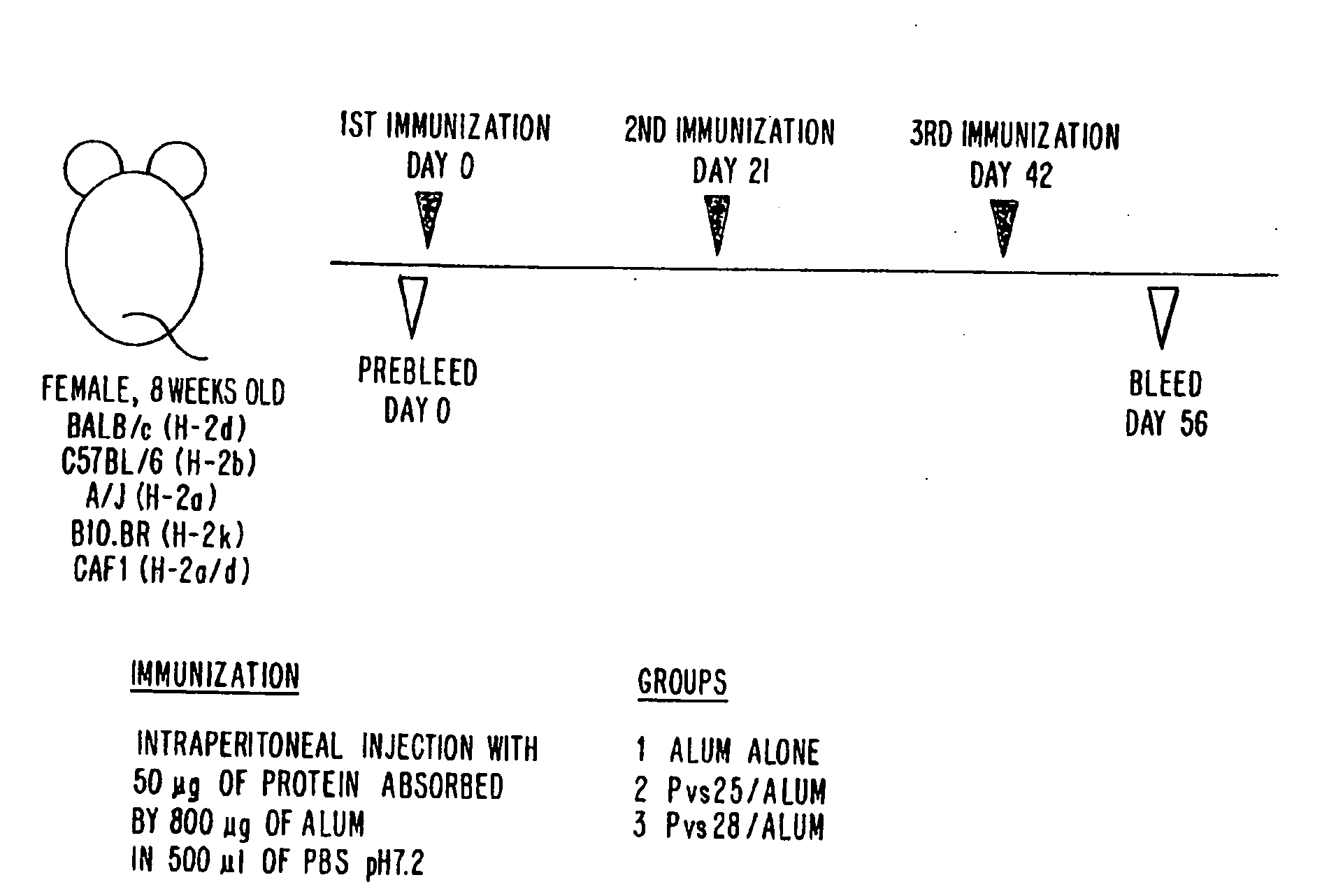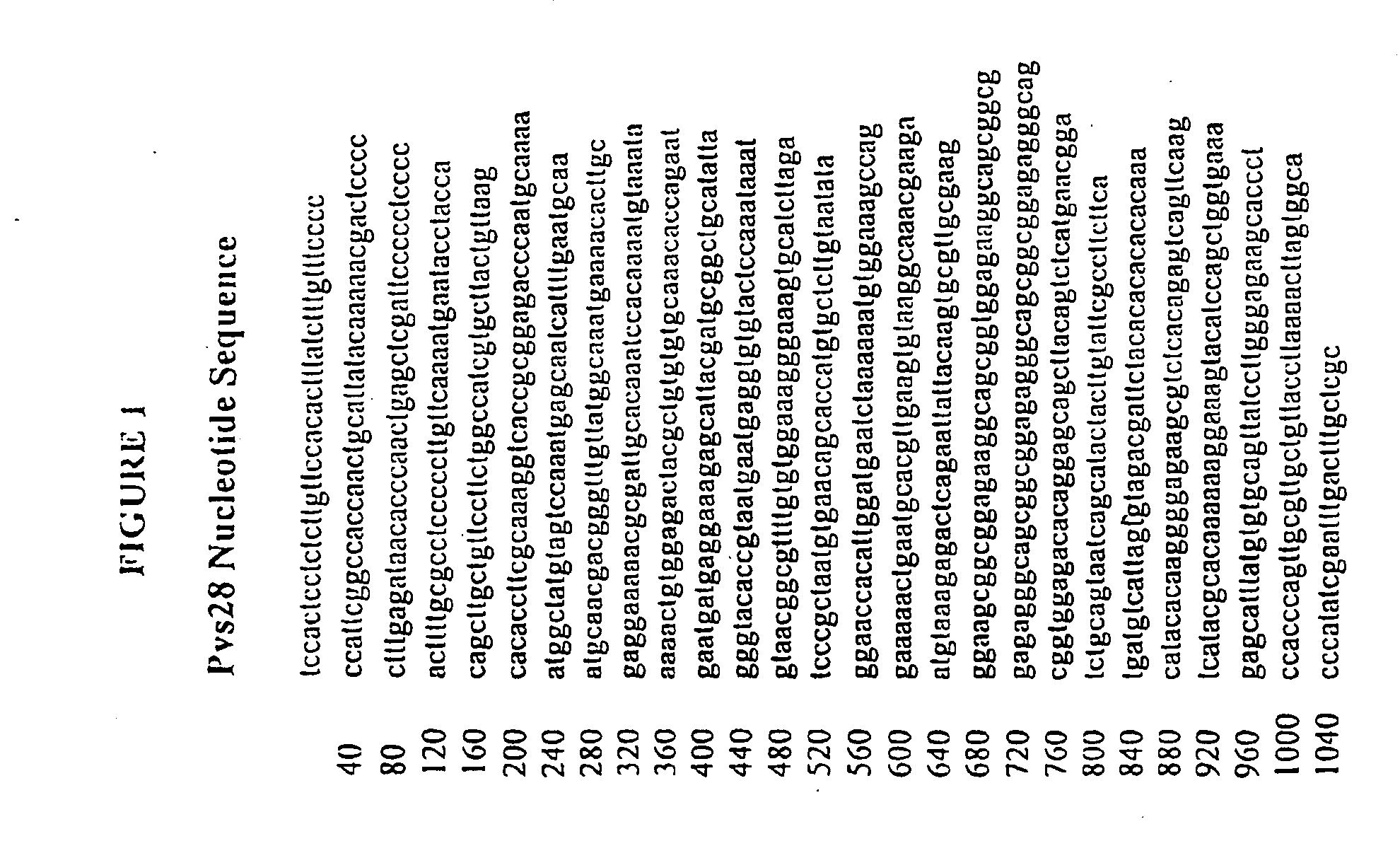Vaccines for blocking transmission of plasmodium vivax
a technology of plasmodium vivax and vaccine, which is applied in the direction of antibody medical ingredients, peptide/protein ingredients, immunological disorders, etc., can solve the problems of malaria that continues to take a heavy toll on mankind, inability to block the transmission of plasmodium vivax, and the need for a transmission-blocking vaccine is great, so as to improve the antigenic properties and simplify the manufacturing of pvs25-pvs28 antigen
- Summary
- Abstract
- Description
- Claims
- Application Information
AI Technical Summary
Benefits of technology
Problems solved by technology
Method used
Image
Examples
example 1
Cloning of Pvs25
[0172]The following example details one exemplary means to isolation of a species of Plasmodium Pvs25. To isolate Plasmodium vivax gene encoding Pvs25, the gene sequences of the eight known proteins-Pfs25, Pgs25, Pys25, Pbs25, Pfs28, Pgs28, Pys21 and Pbs21 were aligned and their sequence similarities analyzed, as described above.
[0173]A highly conserved nucleotide sequence in the first EGF-like domain was identified. This sequence was used to synthesize a degenerate PCR oligonucleotide. To prevent the re-amplification of Pvs28 gene, nucleotides were chosen that were not identical to the Pvs28 sequence. A sense primer (5′-GG(AT) TTT (CT)T(AG) (AG)(CT)T CA(AG) ATG AGT-3′) (SEQ ID NO:6) was constructed. Using this primer with a vector-specific M13 universal primer (5′-GTA AAA CGA CGG CCA GT-3′) (SEQ ID NO:7), nucleic acid sequences were amplified form a P. vivax genomic library (a P. vivax (SalI) genomic library: Sau3AI partial digest cloned into pUC18 BamHI / BAP). The P...
example 2
Expression of Pvs25 in Yeast
[0179]For expression in yeast, a Pvs25 DNA fragment was obtained by PCR amplification, as described above. This Pvs25 subsequence was designed to lack the presumptive secretory signal and glycosylphosphatidylinositol lipid (GPI) anchor (see, e.g., Gowda (1997) J. Biol. Chem. 272:6428-6439) sequences. A polyhistidine tag sequence was also spliced into the polypeptide coding sequence.
[0180]The resultant nucleic acid construct encoding a Pvs25 fusion protein (SEQ ID NO:16) was ligated into the NheI and ApaI restriction sites of the yeast shuttle vector, YepRPEU-3, as schematically represented in FIG. 6. Recombinant clones were electroporated into the host S. cerevisiae strain, VK1, and clones harboring the recombinant plasmid were screened for their ability to secrete a His6 (SEQ ID NO:24) tagged protein. A single high-producing colony was amplified in selective growth media and was used to establish a cell bank for yeast expressed Pvs25.
[0181]For these and ...
example 3
Expression of Pvs28 in Yeast
[0183]For expression in yeast, a Pvs28 DNA fragment was obtained by PCR amplification, as described above. A polyhistidine tag sequence was spliced into the polypeptide coding sequence.
[0184]The resultant nucleic acid construct encoding a Pvs28 fusion protein (SEQ ID NO:17) was ligated into the NheI and ApaI restriction sites of the yeast shuttle vector, YepRPEU-3 (as schematically represented in FIG. 6). Recombinant clones were electroporated into the host S. cerevisiae strain, VK1, and clones harboring the recombinant plasmid were screened for their ability to secrete a His6 (SEQ ID NO:24) tagged protein. High-producing colonies were amplified in selective growth media and used to establish cell banks for yeast expressed recombinant Pvs28.
PUM
| Property | Measurement | Unit |
|---|---|---|
| Fraction | aaaaa | aaaaa |
| Force | aaaaa | aaaaa |
| Length | aaaaa | aaaaa |
Abstract
Description
Claims
Application Information
 Login to View More
Login to View More - R&D
- Intellectual Property
- Life Sciences
- Materials
- Tech Scout
- Unparalleled Data Quality
- Higher Quality Content
- 60% Fewer Hallucinations
Browse by: Latest US Patents, China's latest patents, Technical Efficacy Thesaurus, Application Domain, Technology Topic, Popular Technical Reports.
© 2025 PatSnap. All rights reserved.Legal|Privacy policy|Modern Slavery Act Transparency Statement|Sitemap|About US| Contact US: help@patsnap.com



